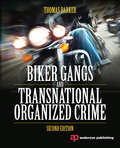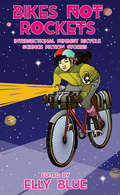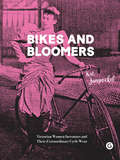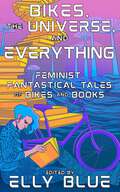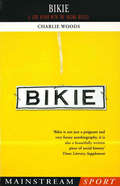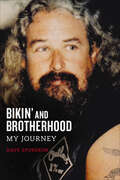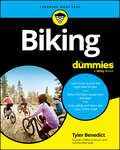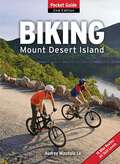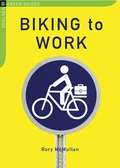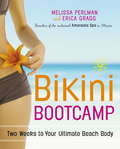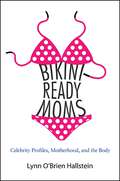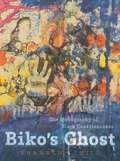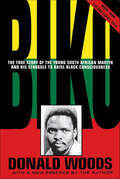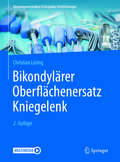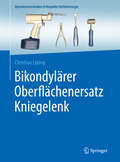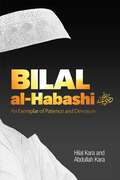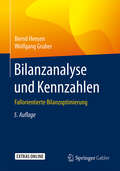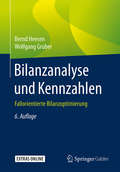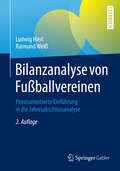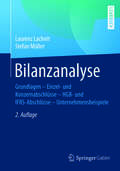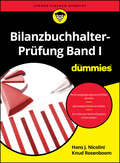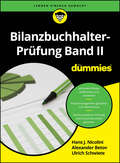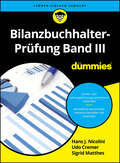- Table View
- List View
Biker Gangs and Transnational Organized Crime
by Thomas BarkerBiker Gangs and Transnational Organized Crime, Second Edition, describes and analyzes a rapidly expanding global problem: criminal acts committed by motorcycle gangs. Thomas Barker, one of the world’s top experts on outlaw biker gangs, offers fascinating details about the Bandidos, the Vagos, the Mongols, and other "one percenters" (criminal biker gangs, as opposed to the vast majority of motorcycle enthusiasts). He combines this data with a strengthened conceptual framework that makes sense of this complicated picture. U.S.-based motorcycle gangs like the Hells Angels have proliferated, especially in Canada and Europe, to the point where these gangs have more members in other countries than in the United States. Increasingly more often in recent years their crimes are not limited to rumbles or drug use—these gangs challenge the dominance of organized crime, leading to violent conflicts between the rivals. Germany, Scandinavia, the UK, the Netherlands, and Canada are particularly hard-hit by this rising violence. One of Barker’s unique contributions is his Criminal Organization Continuum, building on the groundbreaking network approach to organized crime proposed by Klaus von Lampe. Introduced in the first edition, Barker elaborates his continuum tool and makes it more multi-dimensional to help refine the definition of adult criminal gangs. The product of years of research, this book lays the groundwork for further study by offering students, police, and researchers the most thorough account available of outlaw motorcycle gangs.
Bikes Not Rockets: Intersectional Feminist Bicycle Science Fiction Stories
As you ride down the intergalactic bike path, you come to a crossroads. Which path will you take? Your choice could determine your future, or the future of all humanity, forever. These twelve stories explore a variety of intersections set in distant, outlandish, or disturbingly realistic futures and dimensions—all involving bicycles and the breaking of gender stereotypes. A bicycle race spans a rift between worlds. A teenager learns a valuable lesson from her prepper mom. A young fruit seller gets closer to her dream of becoming an astronaut. An overwhelmed mom finds unexpected solace at a bicycle collective. And much more! Contributors include Tuere T.S. Ganges, Gretchin Lair, Ayame Whitfield, Julia K. Patt, Elly Bangs, Osahon Ize-Iyamu, Monique Cuillerier, Kat Lerner, Hella Grichi, and Summer Jewel Keown, with illustrations by Elly Bangs and Paul Abbamondi.
Bikes and Bloomers: Victorian Women Inventors and their Extraordinary Cycle Wear (Goldsmiths Press Ser.)
by Kat JungnickelAn illustrated history of the evolution of British women's cycle wear.The bicycle in Victorian Britain is often celebrated as a vehicle of women's liberation. Less noted is another critical technology with which women forged new and mobile public lives—cycle wear. This illustrated account of women's cycle wear from Goldsmiths Press brings together Victorian engineering and radical feminist invention to supply a missing chapter in the history of feminism.Despite its benefits, cycling was a material and ideological minefield for women. Conventional fashions were unworkable, with skirts catching in wheels and tangling in pedals. Yet wearing “rational” cycle wear could provoke verbal and sometimes physical abuse from those threatened by newly mobile women. Seeking a solution, pioneering women not only imagined, made, and wore radical new forms of cycle wear but also patented their inventive designs. The most remarkable of these were convertible costumes that enabled wearers to transform ordinary clothing into cycle wear.Drawing on in-depth archival research and inventive practice, Kat Jungnickel brings to life in rich detail the little-known stories of six inventors of the 1890s. Alice Bygrave, a dressmaker of Brixton, registered four patents for a skirt with a dual pulley system built into its seams. Julia Gill, a court dressmaker of Haverstock Hill, patented a skirt that drew material up the waist using a mechanism of rings or eyelets. Mary and Sarah Pease, sisters from York, patented a skirt that could be quickly converted into a fashionable high-collar cape. Henrietta Müller, a women's rights activist of Maidenhead, patented a three-part cycling suit with a concealed system of loops and buttons to elevate the skirt. And Mary Ann Ward, a gentlewoman of Bristol, patented the “Hyde Park Safety Skirt,” which gathered fabric at intervals using a series of side buttons on the skirt. Their unique contributions to cycling's past continue to shape urban life for contemporary mobile women.
Bikes for Everyone (Fountas & Pinnell Classroom, Guided Reading Grade 1)
by Amy TichbourneNIMAC-sourced textbook
Bikes, the Universe, and Everything: Feminist, Fantastical Tales of Bikes and Books
by UnknownEver gotten lost in a book? Or on your bicycle? Or both at once, by falling through a portal on the page? Anything is possible in this collection of fifteen very short stories and one comic. Ranging from science fiction to fantasy and traveling in time from a reimagined past to the heat death of the universe, these stories combine the personal and popular power of spokes and words. Meet a young graduate who rides off to become a velo-archivist, a bookstore owner who must learn to bike after cars are banned, a daredevil messenger who makes a harrowing textbook delivery run, a talented scribe who creates a braille bicycle guide, and many more adventurous souls in disparate realities, united by their love for spinning wheels and the written word.Includes stories by Kathryn Reilly, Kiera Jessica Bain, Julie Brooks, Aaron M. Wilson, Elizabeth Frazier, Annie Carl, Grace Gorski, Gretchin Lair, Cherise Fong, L. Y. Gu, Remy Chartier, Mariah Southworth, Dawn Vogel, Summer Jewel Keown, and Aidan Zingler, and a comic by Allison Bannister.
Bikie: A Love Affair with the Racing Bicycle
by Charlie WoodsBikie lays bare the true heart of cycling. Every grass-roots enthusiast, keen racing man and elite professional has one thing in common: he loves his bike and riding it. The author pinpoints the source of his love, tracing its development in the individual, how it draws people into a community and then a tradition – creating a whole worldwide culture to celebrate that deep affection for what is a technological marvel and transcendent experience. Great champions, too, are inseparable from their bikes. They merge into them, becoming a composite image, figures of myth. As well as exerting an emotional hold, cycling, in its famous races, also mounts a living proof of exemplary virtues: courage, perseverance and self-sacrifice – gives us, in fact, a glimpse of the higher reaches of the human spirit. There is a sense of this mythical realm in every pedal turn, for once astride a handbuilt lightweight we are put in touch with the greatest riders of all time.Bikie is the story of one man’s passionate involvement, but in its forthright sincerity it goes to the roots of what we all share.
Bikin' and Brotherhood: My Journey
by David SpurgeonFrom the popularity of cable television shows concerning building choppers or the criminal aspects of the motorcycle gang lifestyle, to the phenomenal success of the Harley-Davidson Motor Company, no one can deny America has become fascinated with bikers and the machines they love. Author Dave Spurgeon provides a firsthand look into the world of the Harley enthusiast and beyond. He takes you to where few have dared to tread—into the sinister, and often misunderstood, reality of the true one-percenters. He takes you on a ride into a place about which many are curious, but few know well. Be advised: This is not the exhaustive work of an investigative reporter, nor an account of the zealous efforts of an undercover law enforcement operation. This is the personal chronicle of Spurgeon&’s 15 years in the fast lane. Sobering, sometimes humorous, yet always painfully accurate, it begins with his love affair with the motorcycle and then continues into the ominous 1%er Brotherhood of the bike gang culture in America. You will be educated, entertained, warned, and enlightened by this brutally honest narrative from a man who has been there and back and lived to tell about it.
Biking For Dummies
by Tyler BenedictExplore, travel, and get fit on two wheels Biking For Dummies will teach you the basics of riding your bike as a workout or as a mode of transportation. Great for people of all ages and fitness levels, this book shows you how to select the best bike for your needs, how to ride safely, and how to maintain your bicycle, so you can enjoy the many adventures that lie ahead. This entertaining Dummies guide answers all your questions about e-bikes, cycling etiquette, must-have gear and gadgets, and staying safe out there. Plus, you’ll find bicycle maintenance advice and tips that will help you get faster and ride farther, even if you’re starting from zero. Become a cyclist, the Dummies way. Choose the right bike for you and find places to ride it Use correct form, learn the rules of the road, and enjoy every ride Learn to keep your bike or e-bike in good shape for years to come Discover which equipment you need, and which you can live withoutBiking For Dummies is for beginners who want to start cycling, and for experienced riders looking for reliable info. Start with a quick ride around the block and branch out to long rides and exciting cycling vacations. There’s no limit to where two wheels can take you.
Biking Mount Desert Island: Pocket Guide
by Audrey Minutolo-LeWith 57 miles of well-tended carriage paths—skirting some of the most beautiful sights on Mount Desert Island and free of automobile traffic—Acadia National park is a very popular destination among bicyclists. Audrey Minutolo-Le provides cyclists with an in-depth look at 18 of the island's finest loop routes, both on and off-road, and gives valuable tips on the prime times to cycle busy sections of Acadia. She also includes many great rides outside the park that are often overlooked. Each route is broken down by mileage, categorized by degree of difficulty, and described in detail with maps to help riders pick routes most comfortable for their skill level.Includes a new introduction and updated information on trails and routes.
Biking to Work
by Rory McmullanA complete guide for making biking to work a safe reality for the beginning bike commuter. For those who live within biking distance to work, this book offers simple safety, bike-buying, gear-buying, and basic maintenance tips, as well as ways to best plan your route to and from the office. By biking to work, you can improve your physical and mental health, save money, avoid creating pollution, and contribute to friendlier cities. In the face of rush-hour traffic, biking is often faster than driving, too!
Biking to Work: A Beginner's Guide
by Rory McmullanIf you are thinking "I can't bike, I live too far from work, I don't want to breathe polluted air, I'm too old, I don't want to get hot and sweaty, I'm unfit..." this book just might change your mind.
Bikini Bootcamp: Two Weeks to Your Ultimate Beach Body
by Mellisa Perlman Erica GraggGet in shape for beach season! This super-slimming, body-sculpting makeover takes off ten pounds and gets you bikini-ready--in just two weeks. Bikini Boot Camp creators Melissa Perlman and Erica Gragg know that the secret to losing weight and getting fit is not another diet or endless hours at the gym. Instead, it's a highly targeted exercise plan combined with healthy, delicious, all-natural foods that jump-start your metabolism and melt away the pounds. At the elite Amansala Eco-Chic Resort and Spa in Mexico, their Bikini Boot Camp program has becomethedestination of choice for celebrities and women everywhere who want to change their bodies and their lives. Now, this book gives you everything you need to recreate the Bikini Boot Camp experience at home--from the signature workouts to the low-cal, Latin-flavored dishes--and achieve the same incredible results. Capturing the spirit of the spa and Mexico's sunny shores, each day of Bikini Boot Camp provides you with: A total-body workoutthat combines walking, circuit training, core strengthening, and yoga to target trouble spots and sculpt you head to toe Energy-enhancing meal plans with slimming, easy-to-follow recipes--a mouthwatering mix of Mexican, Yucatán, and Asian cuisines--straight out of Amansala's kitchen and available here for the first time Mindfulness exercisesto relax and restore you, and to help you stay focused on your fitness goals Do-it-yourself spa treats, from easy facials to herbal baths With more than 75 mix-and-match recipes, and a lifestyle plan to keep you going after the first two weeks are up, Bikini Boot Camp is the fastest way to whip your body into shape--and have fun doing it! So don't panic now that summer is here. No matter how long you've been putting it off, this book gives you everything you need to achieve a bikini body all year round.
Bikini-Ready Moms: Celebrity Profiles, Motherhood, and the Body (SUNY series in Feminist Criticism and Theory)
by Lynn O'Brien HallsteinWinner of the 2016 Outstanding Book Award presented by the Organization for the Study of Communication, Language, and Gender (OSCLG)The requirements of "good" motherhood used to primarily involve the care of children, but now contemporary mothers are also pressured to become bikini-ready immediately postpartum. Lynn O'Brien Hallstein analyzes celebrity mom profiles to determine the various ways that they encourage all mothers to engage in body work as the energizing solution to solve any work-life balance struggles they might experience. Bikini-Ready Moms also considers the ways that maternal body work erases any evidence of mothers' contributions both at home and in professional contexts. O'Brien Hallstein theorizes possible ways to fuel a necessary mothers' revolution, while also pointing to initial strategies of resistance.
Biko's Ghost: The Iconography of Black Consciousness
by Shannen L. Hill&“When you say, &‘Black is Beautiful,&’ what in fact you are saying . . . is: Man, you are okay as you are; begin to look upon yourself as a human being.&” With such statements, Stephen Biko became the voice of Black Consciousness. And with Biko&’s brutal death in the custody of the South African police, he became a martyr, an enduring symbol of the horrors of apartheid. Through the lens of visual culture, Biko&’s Ghost reveals how the man and the ideology he promoted have profoundly influenced liberation politics and race discourse—in South Africa and around the globe—ever since. Tracing the linked histories of Black Consciousness and its most famous proponent, Biko&’s Ghost explores the concepts of unity, ancestry, and action that lie at the heart of the ideology and the man. It challenges the dominant historical view of Black Consciousness as ineffectual or racially exclusive, suppressed on the one side by the apartheid regime and on the other by the African National Congress.Engaging theories of trauma and representation, and icon and ideology, Shannen L. Hill considers the martyred Biko as an embattled icon, his image portrayals assuming different shapes and political meanings in different hands. So, too, does she illuminate how Black Consciousness worked behind the scenes throughout the 1980s, a decade of heightened popular unrest and state censorship. She shows how—in streams of imagery that continue to multiply nearly forty years on—Biko&’s visage and the ongoing life of Black Consciousness served as instruments through which artists could combat the abuses of apartheid and unsettle the &“rainbow nation&” that followed.
Biko: The True Story of the Young South African Martyr and His Struggle to Raise Black Consciousness
by Donald WoodsThe groundbreaking biography that inspired the film Cry Freedom: “A personal testament to a powerful, tragic figure” who led the movement against apartheid (The New York Times Book Review).As the founder of the Black Consciousness Movement, Steve Biko fought to end apartheid and establish universal suffrage in South Africa. As his movement grew, the National Party government began to see him as a threat. On August 13, 1977, Biko was arrested, interrogated, and severely beaten. On September 12, he died in prison.Editor of a leading anti-apartheid paper, Donald Woods was a friend of Steve Biko and went into exile in order to write his testimony about the life and work of a remarkable man.“Courageous and passionate . . . Mr. Woods’s brave attack on the shabby and ultimately murderous expedients of a society dominated by fear and greed should serve as both an inspiration and a warning.” —Christopher Hampton in The Sunday Times
Bikondylärer Oberflächenersatz Kniegelenk (Operationstechniken Orthopädie Unfallchirurgie)
by Christian LüringDas Buch: beschreibt die Implantation eines künstlichen Kniegelenks am Beispiel des DePuy PFC mit einem fixen Inlay. Der Schwerpunkt liegt dabei auf der Praxis: die Operation wird Schritt für Schritt beschrieben. Dabei wird besonderes Augenmerk auf die Fallstricke während der Operation gelegt. Neben den zahlreichen brillanten Grafiken und Fotos, die die Operation visualisieren, wird der Operationsverlauf in einem Video demonstriert. So ist die Umsetzung der Theorie in die Praxis auf kurzem Weg möglich.Das Video: einfach die Springer Multimedia App kostenfrei herunterladen, das Standbild im letzten Kapitel des Buches scannen und das Video streamen.
Bikondylärer Oberflächenersatz Kniegelenk (Operationstechniken Orthopädie Unfallchirurgie)
by Christian LüringDieses Buch beschreibt die Implantation eines künstlichen Kniegelenks am Beispiel des DePuy PFC mit einem fixen Inlay. Der Schwerpunkt liegt dabei auf der Praxis - die Operation wird Schritt für Schritt beschrieben und mit zahlreichen brillanten Grafiken und Fotos visualisiert. Besonderes Augenmerk wird auf die Fallstricke während der Operation gelegt. So wird die Umsetzung der Theorie in die Praxis auf kurzem Weg ermöglicht.
Bilal al-Habashi: An Exemplar of Patience and Devotion
by Hilal KaraBilal al-Habashi recited the first ever call to Prayer. He endured the most unbearable of suffering for the sake of his belief for years. He was one of the Messenger&’s greatest devotees. Medina had become much too constricted for him after Allah&’s Messenger passed away. He possessed an unceasingly belief, love for Allah and His Messenger, and zeal. Realizing that he was about to breathe his last on his deathbed, his wife cried out, &“Woe is me!&” Bilal al-Habashi injected saying, &“Now is not the time for sorrow. It is the time for joy and jubilation, for tomorrow I shall meet the beloved Messenger and his Companions!&”
Bilanzanalyse und Kennzahlen: Fallorientierte Bilanzoptimierung
by Bernd Heesen Wolfgang GruberDieses Buch bietet Orientierung in der Gewinn- und Verlustrechnung und in der Bilanz. Denn ob nach HGB, IFRS oder US-GAAP bilanziert wird: GuV bzw. Bilanz sind von großer Aussagekraft, aber Vieles ist nicht auf den ersten Blick erkennbar. Altes (vor Inkrafttreten des BilMoG) und neues Recht (einschließlich BilRUG) werden hier teilweise parallel behandelt, sodass einerseits Vergleiche und andererseits auch weiterhin Betrachtungen von historischen Abschlüssen in längeren Zeitreihen möglich sind. Die Neuregelungen im Bilanzrecht nach BilRUG werden in der 5. Auflage in einem eigenen Kapitel umfassend behandelt.
Bilanzanalyse und Kennzahlen: Fallorientierte Bilanzoptimierung
by Bernd Heesen Wolfgang GruberDieses Buch bietet Orientierung in der Gewinn- und Verlustrechnung und in der Bilanz. Denn ob nach HGB, IFRS oder US-GAAP bilanziert wird: GuV bzw. Bilanz sind von gro#65533;er Aussagekraft, aber Vieles ist nicht auf den ersten Blick erkennbar. Altes (vor Inkrafttreten des BilMoG) und neues Recht (einschlie#65533;lich BilRUG) werden hier teilweise parallel behandelt, sodass einerseits Vergleiche und andererseits auch weiterhin Betrachtungen von historischen Abschl#65533;ssen in l#65533;ngeren Zeitreihen m#65533;glich sind. Die Neuregelungen im Bilanzrecht nach BilRUG werden in der 5. Auflage in einem eigenen Kapitel umfassend behandelt.
Bilanzanalyse von Fußballvereinen: Praxisorientierte Einführung in die Jahresabschlussanalyse
by Ludwig Hierl Raimund WeißAm Beispiel von 25 europäischen Fußballklubs erklärt dieses Lehrbuch prägnant und verständlich die Grundlagen der Bilanzierung und Jahresabschlussanalyse. Dazu werden die Vermögens-, Finanz- und Ertragslagen der Fußballklubs Schritt für Schritt analysiert, unter ihnen Champions League-Sieger wie Real Madrid, Barcelona, Bayern München, Chelsea, Borussia Dortmund, Juventus Turin, Manchester United, Porto und Liverpool. Besonderheiten bei Fußballklub-Abschlüssen werden ebenso thematisiert wie UEFA-Regularien und deren Auswirkungen auf die wirtschaftliche Leistungsfähigkeit von kleineren Fußballklubs. So aufbereitet werden die komplexen Zusammenhänge besonders greifbar. Das Werk unterstützt Studierende dadurch dabei, beim Lernen ,,am Ball zu bleiben" und bietet fußballinteressierten Praktikern einen anschaulichen Einstieg in die Bilanzanalyse.
Bilanzanalyse: Grundlagen – Einzel- und Konzernabschlüsse – HGB- und IFRS-Abschlüsse – Unternehmensbeispiele
by Stefan Müller Laurenz Lachnit"Bilanzanalyse" stellt umfassend, anwendungsorientiert und auf aktuellstem Stand das Instrumentarium f#65533;r eine gezielte Auswertung des Jahresabschlusses vor. Behandelt wird die Analyse sowohl von Einzel- und Konzernabschl#65533;ssen wie auch von Abschl#65533;ssen nach HGB und nach internationalen Standards. Viele Unternehmensbeispiele verdeutlichen die Analysemethoden und -aussagen und schaffen so die Verbindung zur praktischen Umsetzung.
Bilanzbuchhalter-Prüfung Band I für Dummies (Für Dummies)
by Hans J. Nicolini Udo Cremer Ulrich E. Schwiete Sigrid Matthes Knud Rosenboom Alexander BetovAlles klar für Ihre Prüfung bei der IHK Sie möchten also Bilanzbuchhalter werden? Respekt! Lassen Sie sich bei der Vorbereitung zur Bilanzbuchhalterprüfung von erfahrenen Experten helfen. In einem dreibändigen Werk präsentieren Ihnen sechs erfahrene Trainer und IHK-Prüfer ihr Fachwissen, erklären Ihnen den Prüfungsstoff verständlich und bereiten ihn mithilfe von anschaulichen Beispielen für Sie auf. Sie geben Ihnen Tipps, was Sie in der Prüfung erwartet, und weisen Sie auf wesentliche Fallen bei den Aufgaben hin. Dieser Band enthält den Prüfungsstoff der ersten Klausur. Sie erfahren Wie Sie Geschäftsvorfälle erfassen und nach Rechnungslegungsvorschriften zu Abschlüssen führen Wie Sie ein internes Kontrollsystem entwickeln, einsetzen und sicherstellen
Bilanzbuchhalter-Prüfung Band II für Dummies (Für Dummies)
by Hans J. Nicolini Udo Cremer Ulrich E. Schwiete Sigrid Matthes Knud Rosenboom Alexander BetovAlles klar für Ihre Prüfung bei der IHK Sie möchten also Bilanzbuchhalter werden? Respekt! Lassen Sie sich bei der Vorbereitung zur Bilanzbuchhalterprüfung von erfahrenen Experten helfen. In einem dreibändigen Werk präsentieren Ihnen sechs erfahrene Trainer und IHK-Prüfer ihr Fachwissen, erklären Ihnen den Prüfungsstoff verständlich und bereiten ihn mithilfe von anschaulichen Beispielen für Sie auf. Sie geben Ihnen Tipps, was Sie in der Prüfung erwartet, und weisen Sie auf wesentliche Fallen bei den Aufgaben hin. Dieser Band enthält den Prüfungsstoff der zweiten Klausur. Sie erfahren Wie Sie Jahresabschlüsse aufbereiten und auswerten Was das Finanzmanagement des Unternehmens ausmacht Wie Sie Kommunikation, Führung und Zusammenarbeit aktiv steuern
Bilanzbuchhalter-Prüfung Band III für Dummies (Für Dummies)
by Hans J. Nicolini Udo Cremer Ulrich E. Schwiete Sigrid Matthes Knud Rosenboom Alexander BetovAlles klar für Ihre Prüfung bei der IHK Sie möchten also Bilanzbuchhalter werden? Respekt! Lassen Sie sich bei der Vorbereitung zur Bilanzbuchhalterprüfung von erfahrenen Experten helfen. In einem dreibändigen Werk präsentieren Ihnen sechs erfahrene Trainer und IHK-Prüfer ihr Fachwissen, erklären Ihnen den Prüfungsstoff verständlich und bereiten ihn mithilfe von anschaulichen Beispielen für Sie auf. Sie geben Ihnen Tipps, was Sie in der Prüfung erwartet, und weisen Sie auf wesentliche Fallen bei den Aufgaben hin. Dieser Band enthält den Prüfungsstoff der dritten Klausur. Sie erfahren Wie Sie betriebliche Sachverhalte steuerlich darstellen Wie Sie die Kosten- und Leistungsrechnung zielorientiert anwenden Wie Sie klausurtypische Aufgaben lösen
